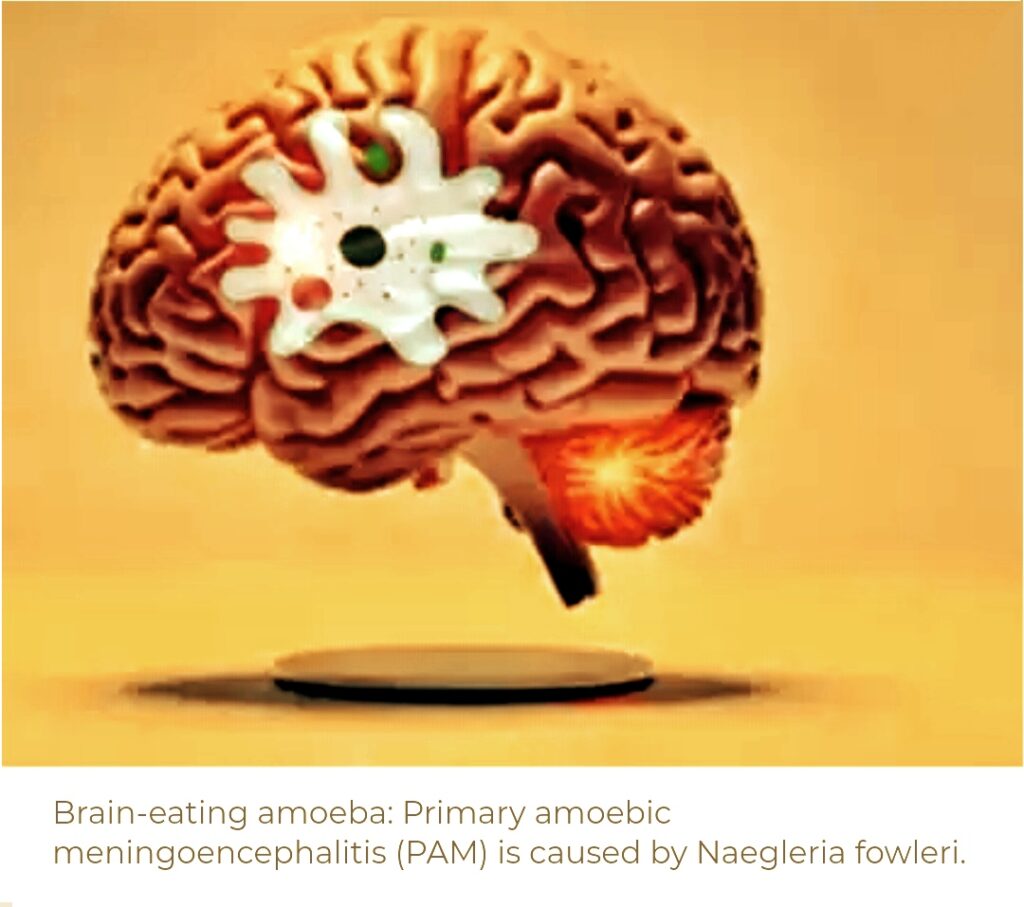Manashimaya

The unfortunate passing of a 14-year-old kid in Kerala has raised awareness of primary amoebic meningoencephalitis, a rare and fatal sickness brought on by the “brain-eating amoeba,” Naegleria fowleri. Since May, there have been three cases reported in Kerala, including this regrettable instance, which has prompted health officials to take urgent preventive action.
Warm fresh water and soil are ideal habitats for the single-celled organism Naegleria fowleri. Humans become infected by breathing it in through their noses, usually when swimming. The amoeba enters the body and proceeds to the brain, where it causes intense inflammation and injury. Primary amoebic meningoencephalitis (PAM) is the name of this infection, which is nearly invariably deadly.
The youngster had been swimming in a small pond when the current case in Kerala was discovered. This incident emphasizes how crucial it is to comprehend the conditions in which this lethal amoeba might infect a person. It is essential to identify the habitats that Naegleria fowleri prefers to fully understand the threat posed by the brain-eating amoeba and its effects in Kerala. The amoeba favors warm freshwater habitats, including rivers, lakes, unkempt swimming pools, splash pads, surf parks, and other outdoor entertainment areas. Given that it can endure temperatures as high as 46 degrees Celsius, these areas could serve as infection hotspots.
People cannot get infected by drinking contaminated water, and the infection is not communicable from person to person. The primary mode of transmission is through the nose, often during water-related activities. Once the amoeba enters the nasal passages, it migrates to the brain, where it destroys brain tissue and causes swelling. This progression highlights the critical need for awareness and preventive measures to protect against this deadly pathogen.
Early intervention for primary amoebic meningoencephalitis requires an understanding of its symptoms. Initial symptoms, such as headache, fever, nausea, and vomiting, are frequently non-specific. More serious symptoms, including a stiff neck, disorientation, seizures, hallucinations, and eventually coma, may appear as the infection worsens. According to the US Centers for Disease Control and Prevention (CDC), most PAM patients pass away between one and eighteen days after their symptoms start. Usually, a coma sets in and the patient passes away after approximately five days.
Currently, there are no definitive treatments for primary amoebic meningoencephalitis. Doctors typically use a combination of drugs, including amphotericin B, azithromycin, fluconazole, rifampin, miltefosine, and dexamethasone. However, these treatments have not been consistently effective. This underscores the critical need for ongoing research and development of more effective therapies to combat this lethal infection.
The lethal nature of Naegleria fowleri is further demonstrated by previous infection episodes. After taking a dip in the Munniyoor river, a five-year-old child from Munniyoor, Malappuram, passed away on May 20 from PAM. Furthermore, after swimming in a pond, a 12-year-old kid from Ramanattukara, Malappuram, developed symptoms that left him in critical condition at Baby Memorial Hospital.
The recent deaths in Kerala highlight how crucial it is to raise public knowledge of the brain-eating amoeba and to take preventative measures. Health officials must keep spreading the word about safety precautions, like avoiding water-related activities in possibly contaminated locations and educating the public about the dangers of warm freshwater settings. We may endeavor to avert similar tragedies and protect public health by exposing the danger posed by the brain-eating amoeba and its effects in Kerala.
